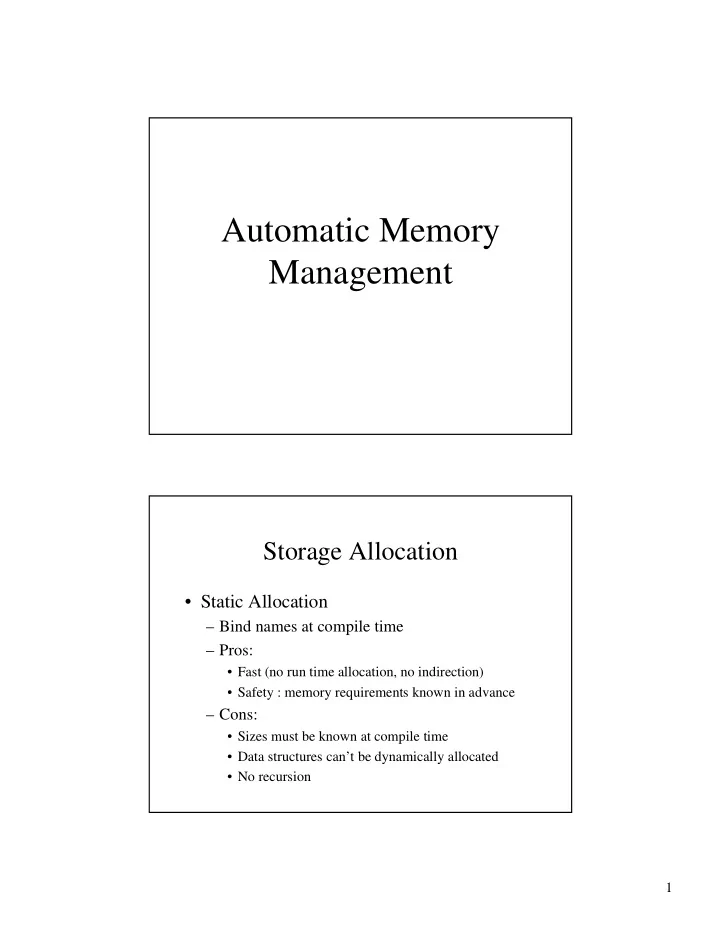

Automatic Memory Management Storage Allocation • Static Allocation – Bind names at compile time – Pros: • Fast (no run time allocation, no indirection) • Safety : memory requirements known in advance – Cons: • Sizes must be known at compile time • Data structures can’t be dynamically allocated • No recursion 1
Storage Allocation • Stack Allocation – activation records (frames) – push + pop on proc entrance / exit – Implications: • Recursion is possible • Size of local data structures may vary • Stack allocated local names can’t persist • Can only return objects of statically known size • Enables function pointers (no nesting though) Storage Allocation • Heap Allocation – Alloc and dealloc from a heap in any order – Advantages: • Local data structures can outlive procedure • Facilitates varying sized recursive data structures • Can return dynamically sized objects • Closures (function + environment) 2
Reachability • What can a program manipulate directly? – Globals – Locals (in registers, on stack, etc) – In C, random locations • Root nodes • Live nodes - pointer reachability Problems w/ Manual Allocation • Garbage - “unreachable” but not free • Dangling references c a t • Sharing b • Failures – Invalid accesses, out of memory errors, etc... 3
Why else would we want AMM? • Language requirements – sharing (system does sharing to save space) – delayed execution • Problem requirements – Should pop() dealloc? Sometimes… • More abstraction, easier to understand • Manual management is hard . Tradeoffs • Problem specification (hard real time) • Costs (time + space) – Traditionally very slow • early 80’s - 40% of time in large LISP programs • typical: 2-20% 4
Reference Counting • Count the number of references to each node • Each mode has a field for the count (rc) • Free nodes: rc = 0 • On referencing, rc++ • On dereferencing, rc-- • When rc returns to 0, free it. Reference Counting • Advantages – Overhead is distributed – Probably won’t affect locality of reference – Little data is shared, most is short-lived • Disadvantages – High overhead on mutator operations (rc++.rc--) – Recursive freeing – Can’t reclaim cyclic structures (Why?) 5
Cyclic Structures A n X 2 Y 2 Z 1 Cyclic Structures • Look for “cycle making” references – 2 invariants: • active nodes are reachable from root by a chain of “strong pointers” • strong pointers do not form cycles – Non termination – Reclaiming objects prematurely 6
Mark and Sweep • Garbage collection • Leave stuff unreachable until a collection • Suspend program during a collection • Mark nodes reachable from the roots • Sweep up the garbage Mark and Sweep root 7
Mark and Sweep mark_and_sweep: for each R in Roots: mark(R) sweep() mark(N): N.mark = MARKED for each C in N.children: mark(C) Mark and Sweep sweep(): Free_List = [] for each Obj in Heap: if Obj.mark == UNMARKED: Free_List.append(Obj) else: Obj.mark = UNMARKED 8
Mark and Sweep • Advantages: – Cycles are handled naturally – No overhead on pointer manipulations • Disadvantages: – Computation halts – Potentially long pauses (O(seconds)) – Locality – Fragmentation Copying Collectors (scavenging) • Divide heap into two semi-spaces • Allocate only into one space at a time • On collection, copy out live data 9
Copying Collectors root A C 0 B 1 D Fromspace Tospace Copying Collectors root A A ’ C 0 B 1 D Fromspace Tospace 10
Copying Collectors root 0 A A ’ B ’ C Put forwarding adress in nodes 0 B in fromspace as we copy them into to space 1 D Fromspace Tospace Copying Collectors root 0 A A ’ B ’ C 0 B 1 D Fromspace Tospace 11
Copying Collectors root 0 A C ’ 1 C D ’ 0 B 1 D Fromspace Tospace Copying Collectors 0 1 New Tospace New Fromspace 12
Copying Collectors • Advantages: – No fragmentation – Only touch cells in use – No free list • Disadvantages: – 1/2 your memory is always unused – Overhead of copying – Copy long-lived objects every time Other Algorithms • The previous algorithms are naïve • Solutions for most problems: – Incremental + Concurrent collection – Tricolor marking • Black: visited • Grey: mutated, or not fully traversed • White: untouched – Generational collection • collect newer spaces; not older ones 13
Garbage Collection for C/C++ • Don’t want to recompile code • Distinguishing pointers w/ a bit flag is bad • Headers in general are bad • Where are the roots? • What are the stack/register conventions? • Which words are pointers? Conservative Collection • Roots: registers, stack, static areas. • Pointer tests: – Does the “address” point into the heap? – Has that heap block been allocated? – Is the address properly aligned? • Machine dependent • Pointer tests on sparc: 30 instructions or so – every time to determine if something is a ptr 14
Recommend
More recommend